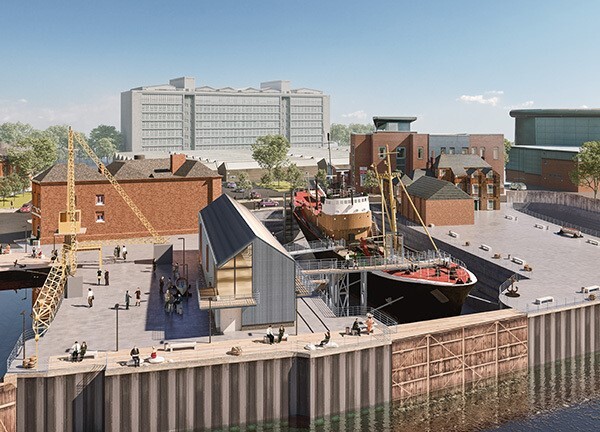
Overview
The North End Shipyard is one of Hull’s significant historic maritime assets.
The relocation of the Arctic Corsair to a permanent dry mooring within the Northern Dry Dock, the erection of a 2-storey visitor orientation centre with footbridge and lift links to the Arctic Corsair and the relocation of Scotch Derrick Crane, are all part of a bigger project to extensively redevelop Hull’s Maritime Museum and its adjacent docks.
Mason Clark Associates were commissioned by Hull City Council through Architect Purcell.
Tasks / challenges
Mason Clark Associates are providing civil, structural and conservation engineering services to assist with relocating the Arctic Corsair and to develop a Shipyard Orientation Centre at the North End Shipyard.
MCA’s engineers have, collaborated with the Council and marine contractors to establish the construction sequence which will allow the removal of the existing gate, mooring of the Arctic Corsair and construction of a permanent flood defence wall. MCA have designed the enclosure of the North End Shipyard, which includes a reinforced concrete flood defence wall, and steel raised floors and access routes to and around the ship.
MCA have investigated significant historic structures, linked with the dry dock, such as the Dock Office Row concrete jack arch bridge built circa. 1850, and the dry dock’s maintenance chamber. MCA drew on their specialist confined space trained engineers to conduct the investigation, and provide condition reports, aiding the council in asset management.
The Mason Clark team have used their skills and contacts within the industry to manage the essential ground investigations which were required to ensure the full scope of the works could be carried out. This area of work included supervising core drilling of the dock base, and intrusive investigations to determine the geometry of the sheet piled dock walls.
Activity
There was much deliberation regarding the design of the gate, MCA’s engineers needed to be flexible with their approach to the design, due to issues and changes beyond our control. One of the challenges posed by the gate was how to best manage the water whilst moving and mooring the Arctic Corsair.
The existing gate was found to be inoperable and will be removed, in order to moor the Arctic Corsair into the dock. The agreed plan for the gate is to construct a permanent framework to the sides and base to the east side of the dock to allow the installation of steel-work/stop logs whilst the dock is fully submerged. Trial erections of posts, stop logs and restraints are planned. The final gate will act as a flood defence wall, assuring safe access to the public to see the history of the dry dock in its original state.
MCA engineers were requested by Hull City Council to undertake a special inspection of the Chamber roof beneath Dock Office Row Highway in accordance with BD63/07. The concern and need for the inspection is to check that the previous bridge structure (under Dock Office Row) is able to support construction traffic during the construction of the museum and the mooring of the ship.